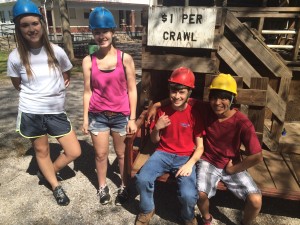Kids Care About Caves!

Originally appears in the Spring 2015 issue
From the Great Barrier Reef off Australia’s coast to the rainforests of South America, and all that is in between, every corner of our world has a unique ecological story worth cherishing and conserving. Kentucky’s Mammoth Cave National Park, which is home to many fragile karst ecosystems, is the perfect example.
Karst landscapes make up almost 25 per cent of the earth’s surface, including one fifth of the United States, and nearly one sixth of Canada.[i],[ii]. Many people are aware of these landscapes, but few understand the biological and ecological importance of these resource-rich systems, and know even less about how they are interconnected with karst formations.
Karst landscapes create specialized habitats for unique animals such as blind fish, crayfish, salamanders, arthropods, and bats.[iii] However, because these ecosystems are home to such specialized species, they are more susceptible to above-ground activities. Even the smallest changes in water pH, water temperature, air temperature, and the presence of foreign substances can greatly impact cave biodiversity. Like many specialized ecosystems, most adverse human impacts are unintentional and are due to a lack of basic knowledge of how karst ecosystems and caves interact. Many regions rich with karst formations have opened up parks and other institutions, not only to provide a means of recreation, but also to educate the community on cave formation and conservation. Visitors are more likely to increase their knowledge and conservation actions when they participate in inquiry investigations and participatory education activities.[iv]
By inviting the public to experience the natural wonders found in their very own backyards through public outreach programs and other engaging opportunities, whole new prospects for environmental stewardship and understanding are created. Through my own partnership with a local institution, my students and I were able to establish one such program that allowed local citizens, as well as the students involved, to become more environmentally aware of unique landscapes beneath their feet. We hope the following description of our work inspires other educators and students to create activities and programs where they live, inviting local citizens to experience their own specialized biological reserves.
To view the photo-rich magazine version, click here.
If you are not already a subscriber, please subscribe to read the full article
Abby Harris is a Biology teacher and cross-country coach at Franklin Simpson High School in Franklin, Kentucky.
References
[i] Veni, G., DuChene, H., Crawford, N., Groves, C., Huppert, G., Kastning, E., Olson, R., Wheeler, B. (2001). Living with karst: A fragile foundation. AGI Envrionemtnal Awareness Series, 4.
[ii] Harley, G., Reeder, P., Polk, J., & van Beynen, P. (2010). Developing a GIS-Based inventory for the implementation of cave management protocols in Withlacoochee State Forest, Florida. Journal of Cave and Karst Studies, 72(1), 35-42.
[iii] Struebig, M., Kingston, T., Zubaid, A., Le Comber, S., Mohd-Adnan, A., Turner, A., & … Rossiter, S. (2009). Conservation importance of limestone karst outcrops for Palaeotropical bats in a fragmented landscape. Biological Conservation, 142(10), 2089-2096.
[iv] Myers, C.M., Myers, L.B., & Hudson, R. (2009). Science is not a spectator sport: Three principles from 15 years of Project Dragonfly. In R. Yaeger (Ed.), Inquiry: The Key to Exemplary Science (pp. 29-40). Arlington, Virginia: NSTA Press.
[v] Rosalino, L., & Rosalino, C. (2012). Nature conservation from a Junior High School perspective. Journal for Nature Conservation, 20(3), 153-161.
Leave a Reply
You must be logged in to post a comment.





